You’ve got your new charcoal grill assembled and ready to go: now, it’s time to figure out how to light it. I use a chimney starter to get my charcoal grill going. Chimney starters are simple, cheap, and effective. You can also use lighter fluid (I wouldn’t) or an electric charcoal starter.
When I’m grilling, I’m almost always grilling over charcoal. I’ve lit thousands of chimneys in my day. Food cooked over charcoal will have more flavor than food cooked on a gas grill. If you want a smoky flavor in your food, a charcoal grill is perfect for you. I’ll walk you through the process of starting your charcoal grill step-by-step.
Ready to learn how to start a charcoal grill? Let’s get the fire going and get to cooking!
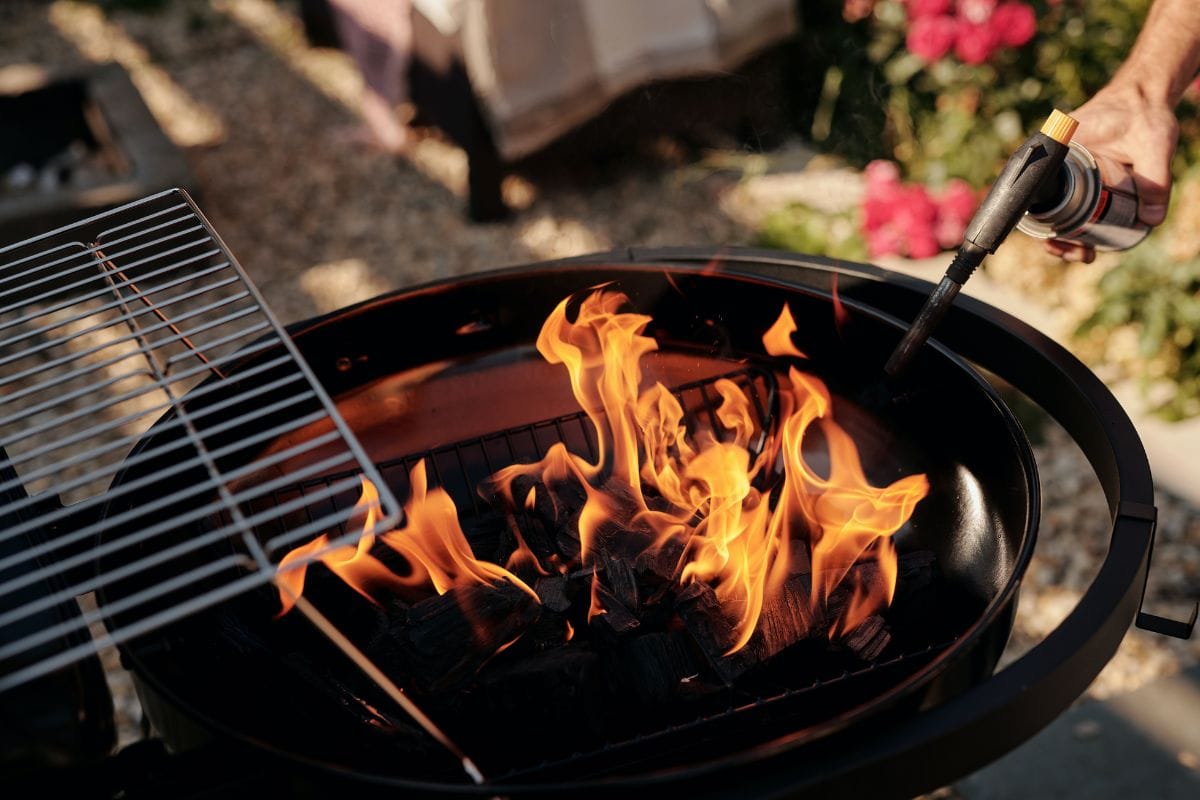
Here’s how to use a charcoal chimney. It’s my preferred method of lighting charcoal – it lets you grill without lighter fluid:
Using a chimney starter is my preferred method of starting a charcoal grill. They’re cheap. They’re foolproof. They last forever. And they don’t taint your food like lighter fluid. I use this one from Weber. The insulated handle is nice, but watch out! If you let the fire burn too long, the handle will still get hot. Wear insulated gloves or use a pot holder if necessary.
If you don’t want to use paper or newspaper, you can use paraffin wax or another similar type of fire starter made from odorless combustible materials. These fire starters get your coals hot more quickly than paper. There are tons of lighter cubes on the market today. Try a few to find your favorite.
To use a fire starter, place it on your firebox (or on the bottom grill grate). Light the fire starter with a match or lighter, then stick the charcoal chimney, filled with new charcoal, on top of it. Boom! You’ve got a fire going.
I’ll say it again – I don’t use lighter fluid. You can smell the hydrocarbons a block away. Many people find that briquettes lit with lighter fluid give food a chemical taste and chemical flavor.
If you’re going to light a charcoal grill with lighter fluid, here’s how to do it:
Lighter fluid is combustible (duh!) and harmful or fatal if swallowed. Safe storage is critical. When not in use, store your lighter fluid out of reach of children in a clean, dry place. Keep lighter fluid away from heat sources. Up high in your garage is an ideal storage area.
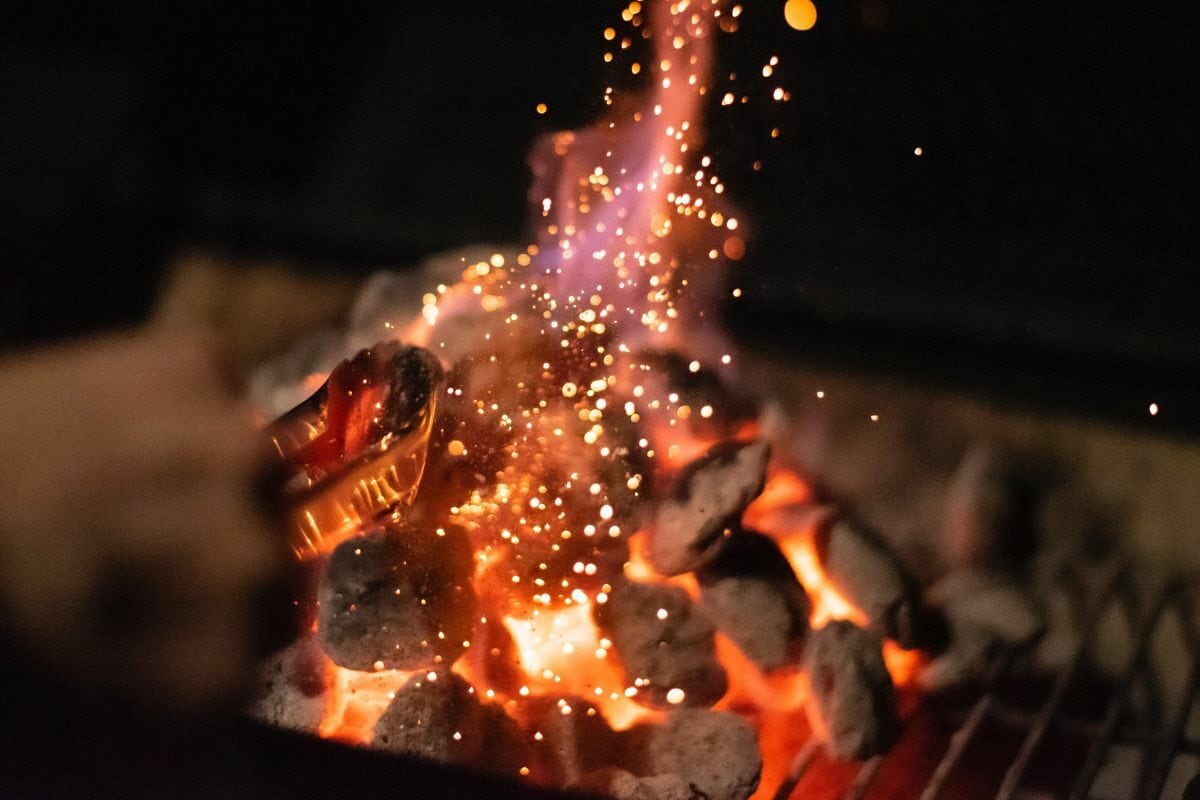
Here’s how to go about lighting your charcoal grill using an electric charcoal starter:
These starters are the least common method for getting lighting a charcoal grill. But they’re a good alternative to charcoal chimneys, with none of the nasty odors or flavors associated with lighter fluid. Here’s a popular model if you’re interested in using an electric starter.
Electric starters resemble curling irons. They cost about twice as much as a chimney starter, depending on the model, but they are foolproof. A nice electric starter should last you a decade or more.
Battery-powered options are available if you’re camping or grilling away from electricity, but they’re pricey.
Charcoal grills are the perfect machine for outdoor cooking because they’re versatile. They can handle weeknight foods like chicken breasts and pork chops. But they can also be used to smoke ribs, briskets, and pulled pork over indirect heat.
Now that you’ve got a fire going, it’s time to set up your charcoal grill. Here are the most common set-ups on charcoal grills:
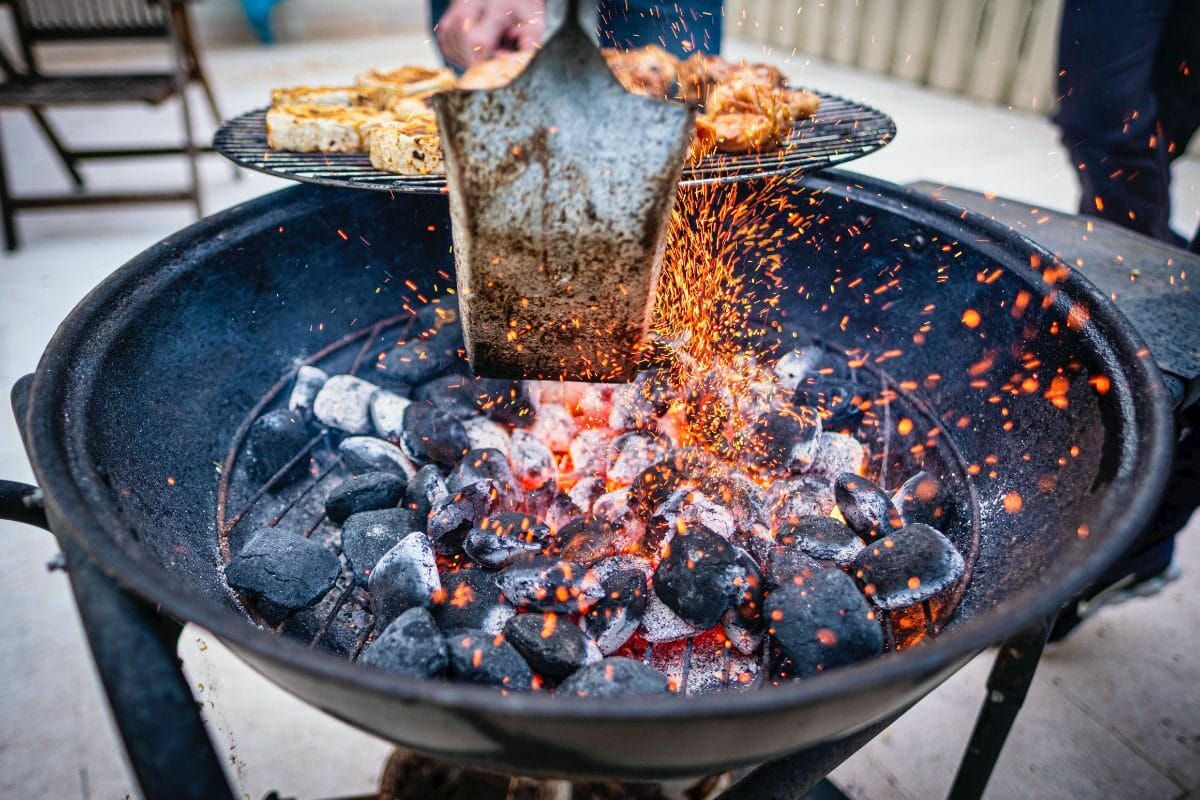
Direct grilling is cooking meat and other foods over direct heat. It’s great for small cuts of meat that are tender, like small pieces of chicken, burgers, hot dogs, steaks, veggies, and fruits. This is high-heat grilling, and if you’re firing up your grill, odds are good it’s to cook over direct heat. There are a few ways to arrange the coals for different types of direct grilling:
Spread the hot coals on 3/4 of the grill. Leave 1/4 of the grill charcoal free. This gives you a hot zone (where the coals are) that you can cook over. The cool zone (where there are no coals) gives you a place to hold food that’s come to a finished temperature. You can also move food to the cool zone if you’ve got flare-ups.
To build a three-zone fire, double the coals on 1/3 of the grill, use a single layer of coals on 1/3 of the grill, and leave 1/3 of the grill free of charcoal. This allows you to sear food at blazing temps where the coals are doubled up. The single layer of coals is where you can grill food that’s been seared. Finally, you’ve got the cool side with no coals, where you can hold cooked foods or move food away from flare-ups.
Indirect grilling means cooking food near (not over) the fire. You’re looking for consistent heat at lower temperatures than those used for direct grilling. It’s the ideal method for cooking larger cuts of meat like whole poultry, baby backs, and pork shoulder. You’re turning your grill into a charcoal fueled oven. Indirect grill your food at low enough temperatures (300°F or lower), and you’ll be slow cooking.
To set up your charcoal grill for indirect grilling, rake all the coals to one side of the grill. Place your food on the side with no coals. Place a drip pan underneath the food being cooked. The drip pan will keep fats off your grill, reducing the odds of a future flare-up.
You can also rake the hot charcoal to both sides of the grill and place the food in the center. There are charcoal baskets you can use, as well, that fit snugly to the sides of your grill.
Smoking, also known as barbecue, is the Holy Grail of outdoor cooking to some people. It’s a form of indirect grilling. Food is placed near a fire. Smoking involves low heat (generally 350°F or less, often 225°F) and adding wood chips or wood chunks to a charcoal grill. The wood infuses the food with a delightful smoky flavor and aroma.
To smoke on your charcoal grill, set it up for indirect grilling. Place a drip pan under where the food is going. Once your coals are ready, dump them to the side. Toss a handful of chips or 3 or 4 chunks on the fire. Get your grill to temperature, and put your food on the side with no coals. It’s a simple as that! Monitoring cooking temps is critical with BBQ. Try to keep your grill temperature at your recipe’s recommended temp.
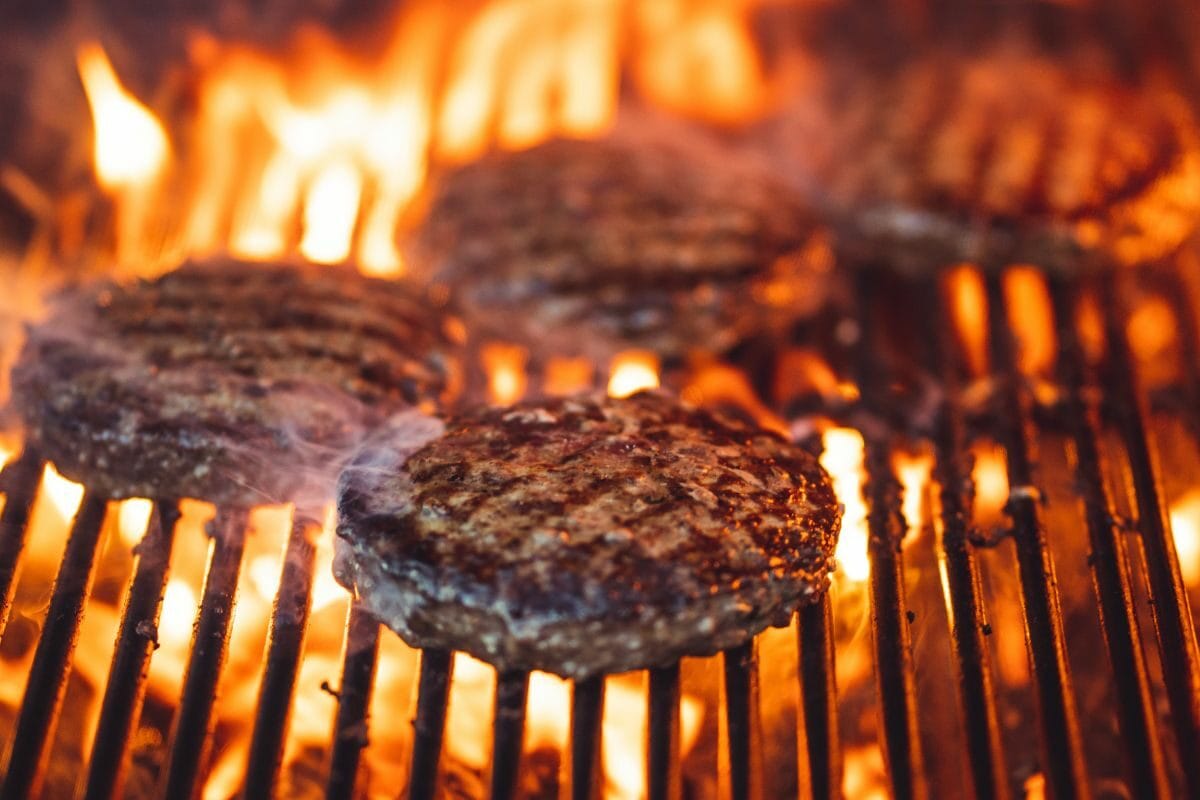
Using lump charcoal or briquettes is a raging debate within the BBQ community, pitting grillmasters against each other like the Montagues and Capulets. I use charcoal briquettes, specifically the Kingsford brand. I’ve used plenty of lump charcoal. It’s good stuff. It’s also twice as expensive as briquettes and doesn’t burn as evenly.
I think the differences between the two fuel sources are pretty minor and not worth getting worked up about. Try a bag of both and see which you prefer. The “right charcoal” is whatever works best for you.
Start a charcoal grill with lump charcoal the same way you would with briquettes. A charcoal chimney or electric starter is preferred. Use lighter fluid in a pinch.
While outdoor grilling may seem mundane, open flames have an inherent risk of danger. Be smart with your fire. Keep flames away from your home. Use heat-resistant gloves when handling hot objects. Keep pets and children away from your grill. Having a fire extinguisher nearby is a good idea.
If your fire gets out of control, close the vents. Doing so will remove oxygen and smother the fire.
Yes, leave the grill open, regardless of the fire-starting method you’re using.
If using lighter fluid or an electric charcoal starter, let the charcoal pile burn for 10-15 minutes. Then shut your grill’s dome and let the grill come to temperature.
For a chimney, let the chimney burn until the coals are ashy, around 15 minutes. Then dump out the coals into the kettle, and allow the grill to come to your desired cooking temperature.
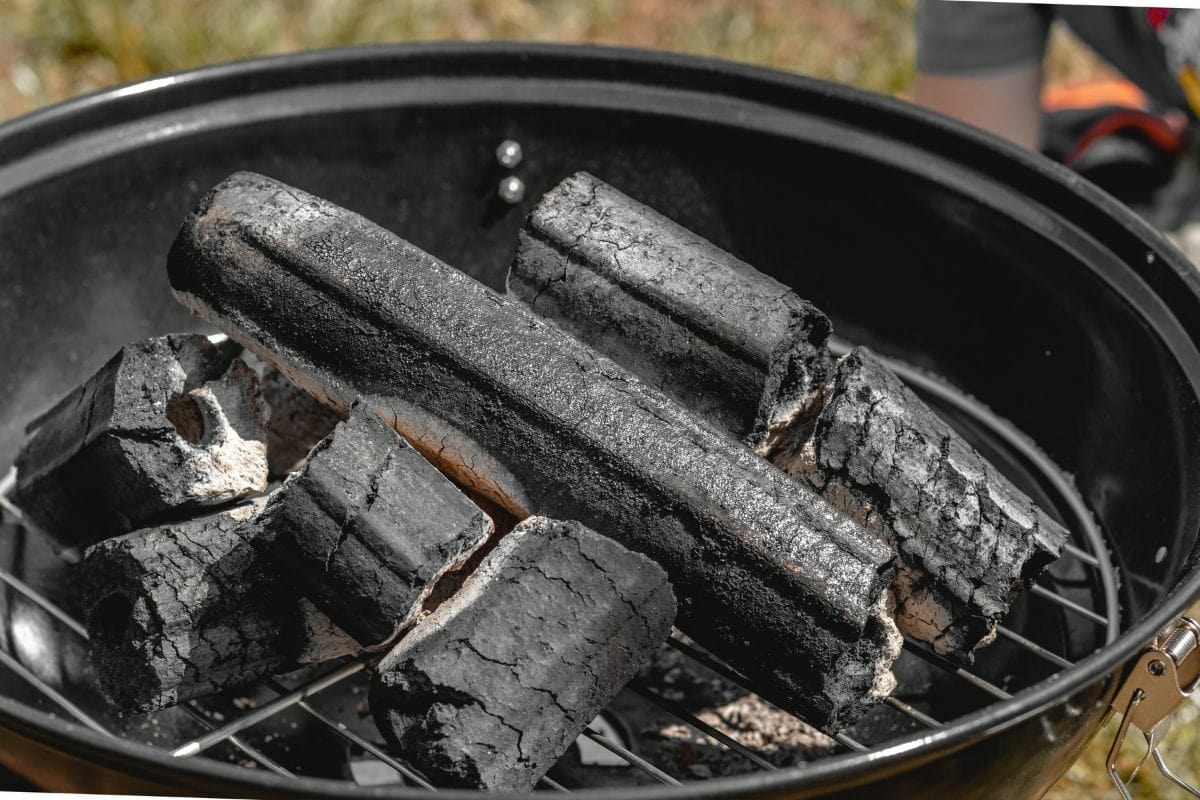
There it is, your comprehensive guide on how to light charcoal for your charcoal grill. It’s easy to light a charcoal grill if you use a chimney or an electric fire starter. Lighter fluid works but may contribute foul odors and flavors to food. I prefer to ditch lighter fluid in favor of the other methods.
Now that you know how to get your charcoal grill burning hot, it’s time to crank out some delicious meals for your friends and family! Happy grilling.